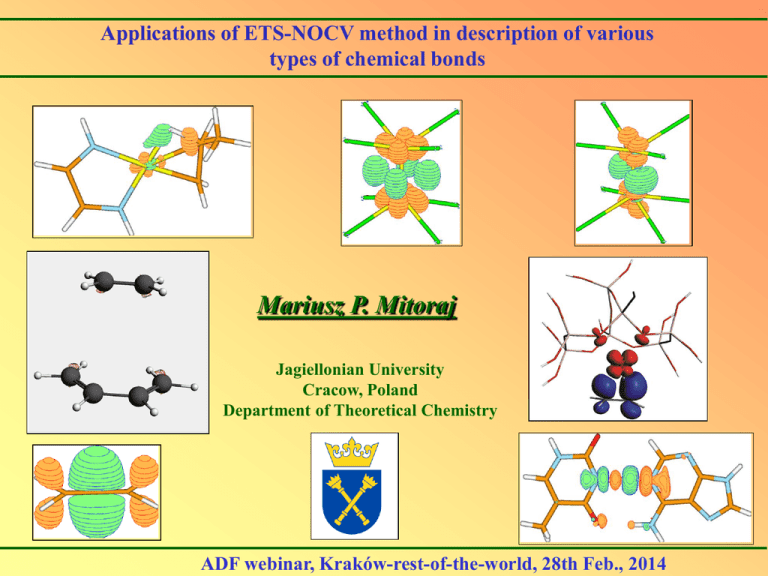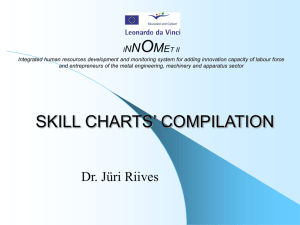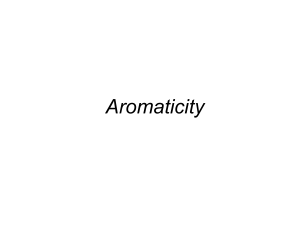Mitoraj_ETS-NOCV
advertisement

Applications of ETS-NOCV method in description of various types of chemical bonds Mariusz P. Mitoraj Jagiellonian University Cracow, Poland Department of Theoretical Chemistry ADF webinar, Kraków-rest-of-the-world, 28th Feb., 2014 Examples of theoretical quantities for visualization of chemical bond ADF webinar, Kraków-restoftheworld, 28th Feb., 2014 Formation of chemical bond in H2 – based picture 1. Start from promolecular state (atom/fragments) H H H2 H=1s2 H H 2 2H H=1s2 H Deformation density (Differential density) (1) qualitative data by inspection of the sign of : negative (outflow), positive (inflow) of density due to bond formation ADF webinar, Kraków-restoftheworld, 28th Feb., 2014 The Natural Orbitals for Chemical Valence (NOCV) NOCV’s ( ψ i C ij * λ i) diagonalize the deformation density matrix: i PC i v i C i ; i = 1, M where P=P-P0 , density matrix of the combined molecule, P0- density matrix of the considered molecular fragments. NOCV’s also decompose the deformation density : useful qualitative data by inspection of the sign of : negative (outflow), positive (inflow) of density M ρ(r) 2 vkψk (r) k 1 NOCV’s are in pairs: M /2 (r ) v k [ k (r ) k ( r)] 2 k1 2 M /2 k ( r) k1 Radoń, M. Theor Chem Account 2008, 120,337. Mitoraj, M.; Michalak, A. Organometallics 2007, 26(26); 6576., Michalak, A.; Mitoraj, M.; Ziegler, T. J. Phys. Chem. A. 2008, 112 (9), 1933, Mitoraj, M.; Michalak, A. J. Mol. Model., 2008, 14, 681, Mitoraj, M.; Zhu, H.; Michalak, A.; Ziegler, T. 2008, International Journal of Quantum Chemistry, DOI: 10.1002/qua.21910., Mitoraj, M.; Michalak, A. J. Mol. Model. 2008, 14, 681. The contours of the deformation density () and the contributions from the pairs of complementary orbitals for the heme/CO system n (r ) i i r 2 i 1 q = 0.74 q = 1.04 donation back donation back donation A combination of ETS and NOCV - (ETS-NOCV) ETS: -De=Etotal= Edist + Eelstat + EPauli + Eorb λμ E orb electronic factor Pλμ Fλμ orb TS N/2 NOCV: ρ orb (r) N/2 2 2 v k [ ψ k ( r ) ψ k ( r )] k 1 ρ k (r) k 1 ETS-NOCV: E orb Tr( P orb F TS ) Tr ( C P orb CC N/2 F TS C) k 1 M /2 E orb k 1 N/2 TS TS v k [ F k , k Fk , k ] M /2 TS v k [ F k TS F k ] k k E orb E k orb k 1 Energetic estimation of k Mariusz P. Mitoraj, Artur Michalak and Tom Ziegler „A combined charge and energy decomPosition scheme for bond analysis” J. Chem. Theory Comput., 2009, 5 (4), pp 962–975. Dative bonds – systems with symmetry (CO)5Cr=CH2 donation back donation Donor/acceptor properties of ligands for Ni(NH3)3 X complexes: :CN- > PH3 > NH3 > C2H4 > CS > CO > N2 > NO+ :NO+ > CS > CO > N2 > C2H4 > PH3 > CN- > NH3 Mitoraj Mariusz, Michalak A (2007) „ Donor-Acceptor Properties of Ligands from the Natural Orbitals for Chemical Valence” Organometallics, 26, 6576-6580 Dative Bond NH3BH3 - Calculations • Define closed shell fragments, NH3 and BH3 • Run SP calculations to get the fragment MO’s • Run SP ETS-NOCV calculations for whole molecule in the basis of previously calculated fragment MO’s Dative Bond NH3BH3 - Calculations M.Mitoraj J. Phys. Chem. A, 2011, 115 (51), pp 14708–14716 Crystal of Ammonia Borane, NH3BH3 M.Mitoraj J. Phys. Chem. A, 2011, 115 (51), pp 14708–14716 Inter-Molecular-Hydrogen Bonds Adenine-Thymine kcal/mol, (BP86/TZ2P) A-T Eint -13.0 Eorb -22.0 EPauli 38.7 Eprep 2.1 Eelstat -31.9 Etotalexperiment99 -12.1 Etotal – other theoretical results Eorb=-22.0 -13.2 O*(H-N) N*(H-N) O-H H-N covalency! Rafał Kurczab, Mariusz P. Mitoraj, Artur Michalak and Tom Ziegler J. Phys. Chem. A,2010, 114, 8581. Hydrogen Bond A-T Calculations • Define closed shell fragments, Adenine and Thymine • Run SP calculations to get the fragment MO’s • Run SP ETS-NOCV calculations for whole molecule in the basis of previously calculated fragment MO’s ADF webinar, Kraków-restoftheworld, 28th Feb., 2014 Covalent bonds CH3-CH3 CH2=CH2 GeH2=GeH2 H3CCCCH3 Quadruple bond; Re2Cl82[-84.3 kcal/mol] 2[-65.5 kcal/mol] 1[-65.5 kcal/mol] [-1.3 kcal/mol] Typical-Multiple bonds-TM Cr2, formally sixtuple bond, bCr2-Nal = 6.01 Etotal=-31.3kcal/mol Eorb=-242.7 Esteric=211.4 Eorb=-242.7 kcal/mol J. Chem. Theory Comput., 2009, 5 (4), pp 962–975. Ethane Built from two methyl radicals 1. Define CH3 regions (uneven number of electrons); 2. Run SP RESTRICTED ! Calculations for CH3 fragments to get the fragment MO’s; (1/2 + 1/2 electrons for SOMO of CH3) 3. Use fragoccupations keyword in order to keep the right occupations for each CH3 fragoccupations f1 A 5 // 4 subend f2 A 4 // 5 subend End 4. Run SP ETS-NOCV calculations for whole molecule in the basis of previously calculated fragment MO’s -alpha-and beta-NOCV’s Typical-Multiple bonds-TM Cr2, sextuple bond, bCr2-Nal = 6.01 Etotal=-31.3kcal/mol Eorb=-242.7 Esteric=211.4 Eorb=-242.7 kcal/mol J. Chem. Theory Comput., 2009, 5 (4), pp 962–975. Cr2 Built from two Cr+Cr 1. Define Cr regions (uneven number of electrons); 2. Run SP RESTRICTED ! Calculations for Cr fragments using OCCUPATION keyword (A 18 1 1 1 1 1 1); Should be like Cr but it is Cr 6* (1/2 + 1/2) so we must: 3. Use fragoccupations keyword in order to keep the right occupations for each Cr. fragoccupations Region_1 A 15//9 subend Region_2 A 9//15 subend End Cr Cr 4. Run SP ETS-NOCV calculations for whole molecule in the basis of previously calculated fragment MO’s Better Fragment MO’s from unrestriced run: advanced ’manual’ usage ADF uses in principle only ‚rectricted’ fragments, however, one might cheat him 1. Run open shell calculations for a given fragment; 2. Save tape21 ascii (dmpkf) copy the final MO’s (from the section Eig-CoreSFO_A, MO’s expressed in SFO); 3. Run fragment calculations by setting SCF=0 wrong MO’s save tape21asciifind Eig-CoreSFO_A section, then: 4. Take MO’s and occupations, energies, from step 2 and paste them to Tape21 from step 3…..it gives you right fragment MO’s Transform asciibinary(udmpkf); 5. Rerun final ETSNOCV calculations (do not recalculate the fragments!) Agostic intramolecular RH---Metal interaction Ni-diimine cationic Brookhart model catalyst C-H polarization Ni-C C-C Mariusz P. Mitoraj, Artur Michalak and Tom Ziegler „On the Nature of the Agostic Bond between Metal Centers and -Hydrogen Atoms in Alkyl Complexes. An Analysis Based on the Extended Transition State Method and the Natural Orbitals for Chemical Valence Scheme (ETS-NOCV)” Organometallics, 2009, 28 (13), pp 3727 Halogen Bonding CF3I---NH3 from ETS-NOCV perspective H H F N H I C F F Charge outflow, increase positive charge ETSNOCV(red-outflow,blue-inflow) -8.3 kcal/mol N-I covalency N*(C-F) charge accumulation, increase s-character (pointed out by prof. Grabowski) Grabowski S. Chem. Rev., 2011, 111 (4), pp 2597–2625 Halogen Bonding CF3I---NH3 from ETS-NOCV perspective Domination of the electrostatic factor is due to the presense of σ-hole on iodine atom: F F I F (Politzer P, Lane P, Concha MC, Ma Y, Murray J (2007) JMolModel, 13, 305, „An Overview of Halogen Bonding” Halogen Bonding CF3I---NH3 from ETS-NOCV perspective Prof. Politzer, „Program & Book of Abstracts”, MIB 2011, „….The weakness of this interpretation (electrostatic) is that it is simple and straightforward, and therefore is viewed by some with suspicion. F F C F F I -hole I (C-F) bond F F Electrostatic potential picture Charge Anisotropy ETS-NOCV picture Can ETS-NOCV discriminate between halogen and hydrogen bonding within the same molecule? Anion receptor based on urea, which involve hydrogen and halogen Bonding at the same time|: Chudzinski, et all, JACS, 2011, 133, 10559 Can ETS-NOCV discriminate between halogen and hydrogen bonding within the same molecule? -22.3 kcal/mol -6.3 kcal/mol Yes: ETS-NOCV can separate halogen and hydrogen connections Cl- / rest • Define closed shell fragments, Cl minus + rest of the complex • Run SP calculations to get the fragment MO’s • Run SP ETS-NOCV calculations for whole molecule in the basis of previously calculated fragment MO’s ADF webinar, Kraków-restoftheworld, 28th Feb., 2014 Thank You very much for Your Attention! ADF webinar, Kraków-restoftheworld, 28th Feb., 2014







